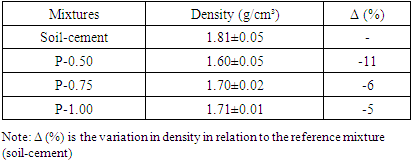-
Paper Information
- Paper Submission
-
Journal Information
- About This Journal
- Editorial Board
- Current Issue
- Archive
- Author Guidelines
- Contact Us
International Journal of Materials Engineering
p-ISSN: 2166-5389 e-ISSN: 2166-5400
2024; 14(1): 1-11
doi:10.5923/j.ijme.20241401.01
Received: Jan. 1, 2024; Accepted: Jan. 22, 2024; Published: Jan. 27, 2024

Adobe Soil-Cement Bricks with Expanded Polystyrene Residue Addition Reinforced with Polyethylene Fibers
Rânfler José Luan Rodrigues Soler, Raul Tadeu Lobato Ferreira
Earth and Exacts Sciences Institute (ICET), Federal University of Mato Grosso, Barra do Garças, Mato Grosso, Brazil
Correspondence to: Raul Tadeu Lobato Ferreira, Earth and Exacts Sciences Institute (ICET), Federal University of Mato Grosso, Barra do Garças, Mato Grosso, Brazil.
| Email: |  |
Copyright © 2024 The Author(s). Published by Scientific & Academic Publishing.
This work is licensed under the Creative Commons Attribution International License (CC BY).
http://creativecommons.org/licenses/by/4.0/

The rescue and the improvement of the earth construction techniques are presented as an interesting alternative for the sustainable development of the construction sector, not only for reducing the generation of residues during the construction process, but also for making possible the reuse of the residues generated by the own construction industry and by other sectors. Within this context, the present study proposes an evaluation of soil-cement adobe bricks with the addition of expanded polystyrene residue and reinforced with polyethylene fibers, by checking the compressive strength, shrinkage and cracking of the mixtures, for a curing period 7 days. For that, bricks obtained with incorporation of 0.5%, 0.75% and 1.00% of polyethylene residue and with an incorporation of 0.125%, 0.25% and 0.50% of expanded polystyrene residue were obtained, with the purpose of analyzing the effect of each addition, relating the results obtained to the physical character-istics of the proposed materials. The expanded polystyrene residue incorporation in the soil-cement matrix promoted losses of resistance to simple (uniaxial) compression, while the polyethylene fibers incorporation promoted strength gains, and neutralized the retraction and cracking of the soil-cement mixture. A simultaneous incorporation of the two residues shown to be ad-vantageous resulting in a lighter, more resistant brick with less potential for shrinkage.
Keywords: Raw brick, Compressive Strength, Earth construction
Cite this paper: Rânfler José Luan Rodrigues Soler, Raul Tadeu Lobato Ferreira, Adobe Soil-Cement Bricks with Expanded Polystyrene Residue Addition Reinforced with Polyethylene Fibers, International Journal of Materials Engineering , Vol. 14 No. 1, 2024, pp. 1-11. doi: 10.5923/j.ijme.20241401.01.
Article Outline
1. Introduction
- The macrocomplex of the construction industry is the main generator of waste in society. According to data from the Brazilian Association of Public Cleaning and Special Waste Companies, over 48 million tons of construction and demolition waste (CDW) were collected in Brazil in 2021 [1]. Despite a significant portion of these materials being recycled, a considerable amount is degrading in the environment, releasing carbon dioxide (CO2), polluting rivers and seas, occupying space in sanitary landfills. Additionally, some waste releases harmful substances to human health [2].Furthermore, the construction sector is a major consumer of natural raw materials. It is estimated that about 50% of the total natural resources consumed by society are used by the construction industry. This significant environmental impact has led several countries to adopt specific environmental policies for the sector. Among these policies, the reuse of resources, the use of renewable resources, reduction of resource consumption, and environmental protection are emphasized. The incorporation of waste into material production can reduce energy consumption and transportation distances of raw materials. Moreover, the incorporation of waste can enable the production of materials with improved technical characteristics in various areas [3-7].The final disposal of waste is one of the major problems faced by the world today. Therefore, it is interesting to find ways to incorporate waste into the construction process, aiming not only to minimize the impacts generated by the construction industry but also to address issues related to solid waste generation in general.Current consumption patterns promote the excessive generation of waste, causing both social and environmental problems [8]. Globalization is one of the factors that most influences consumers to buy excessively. With each purchase, a new package enters circulation, and if discarded improperly, it leads to accumulations and negative impacts on the environment. Plastic bags easily spread in the environment, causing a series of problems. The drainage network is one of the main ways wastes are conveyed, and combined with unsustainable consumption patterns, it favors the accumulation of package in drainage devices (curbside drains, storm drains, major stormwater drains, etc.), which can subsequently lead to flooding, causing problems for society and the urban landscape [9].The amount of plastic waste found in municipal solid waste can vary from 7 to 30%. Despite the increase in Brazilian plastic recycling rates, only about 32% of Brazilian municipalities has an implemented selective collection system, according to a 2023 survey by the Business Commitment for Recycling (CEMPRE) [10]. Plastic waste in landfills and the environment, in addition to the visual impact, can release toxic substances such as plasticizers and other additives. After disposal, landfilling is the least favorable option, with reuse, recycling, and incineration being suitable disposal possibilities [11].Incineration involves burning and decharacterizing waste, allowing a significant reduction in volume. However, it is a process that requires high investments and produces gases from the combustion of waste, potentially hazardous to both human health and the greenhouse effect [12]. According to Vanapalli et al. [13], burning plastic waste produces toxic and carcinogenic gases. The most appropriate form of plastic reuse is recycling, with mechanical recycling being the most widely used worldwide [14,15].Expanded polystyrene (EPS) is a material composed of 98% air and only 2% carbon and hydrogen. Although it does not chemically contaminate soil, water, or air, it is a chemically inert, non-biodegradable material that becomes an environmental problem if not recycled. Therefore, the reuse of expanded polystyrene becomes a valuable sustainable measure [16,17].Sustainable development involves meeting the needs of the present without compromising the ability of future generations to meet their own needs [18]. However, the achievement of sustainable development requires transformative changes in the construction industry. The construction sector generates environmental impacts due to the high consumption of natural resources and energy in the production and transportation of materials, as well in the improper disposal of waste and packaging on construction sites, which often occurs inadequately [19].The quantity of waste generated by construction processes is a daily concern, given the numerous problems caused by the accumulation of debris. In an effort to promote sustainable development, some professionals and construction companies have sought to use sustainable construction techniques to minimize the environmental impacts caused by the sector. In this context, earth constructions, specifically adobe bricks, also known as raw earth bricks, allow the reuse of these materials, and from an economic perspective, there are significant cost reductions due to abundant and low-cost raw materials. Considering that adobes have a simplified production process and do not require firing, the price becomes even more accessible for both production and the end consumer. Additionally, they provide good thermal and acoustic comfort in buildings [20].Adobe bricks have great versatility in their composition. Essentially produced from raw earth, other materials can be incorporated to meet specific needs, such as increased strength, lower specific weight, reduced shrinkage, among others. Several studies have been conducted in this field, assessing the adaptability to added materials, as demonstrated by studies conducted by Schweig et al. [21], Santos et al. [22], and Barroso, Novato, and Ferreira [23]. In Brazil, the requirements and test methods for this type of masonry are regulated by the Brazilian Association of Technical Standards (ABNT) through standard NBR 16814 [24].Aiming to control shrinkage and cracking in soil-cement ecological bricks, this work sought to add polyethylene fibers to the composition. This material, commonly used in packaging that requires high cracking resistance under tensile stress [25], was obtained by processing plastic bags distributed in the common market, which are usually discarded improperly in nature.To obtain bricks with lower specific weight, EPS particles obtained from the processing of waste of this material were added. As it is mostly composed of air, this material acts as a void incorporator, thus providing a lower weight to the block [26]. Furthermore, the use of sealing construction elements with the incorporation of EPS can contribute to reducing energy consumption for the thermal conditioning of buildings [27]. Therefore, by reusing these materials, the goal was to produce a resistant brick with reduced apparent weight and low tendency to shrinkage and cracking, which can bring significant improvements to the construction of earthen buildings.
2. Material and Methods
- The employed methodology aims to assess the effect of incorporating polyethylene fibers and expanded polystyrene waste into soil-cement adobe bricks. For this purpose, different addition contents were proposed to study the incorporation of the waste separately, and subsequently, a mixture with the incorporation of both wastes together. The evaluation of the proposed mixtures was conducted through uniaxial compressive strength tests and shrinkage tests.
2.1. Soil
- The present study used soil extracted in 2017 from an area near the margins of the road contour connecting BR-070 and BR-158 highways, as well as close to MT-100 highway, located in the municipality of Pontal do Araguaia – MT. After collection, the soil was disaggregated and sieved, discarding the gravel fraction. Schweig et al. [21], using the American Association of State Highway and Transportation Officials (AASHTO) methodology, classified the soil as granular material of class A-2-4 (0), characterized as silty or clayey sand. The results of the characterization tests are presented in Table 1.
|
2.2. Portland Cement
- The binder used in this research to stabilize and improve the chosen soil was Portland cement combined with pozzolan, classified by the Brazilian standard, NBR 16697, as CP II-Z 32 [28]. Considering the soil classification and following the recommended proportions by the Brazilian Portland Cement Association (ABCP), the cement content adopted for the mixtures was 7% relative to the dry mass of the soil [21,29].
2.3. Polyethylene Fibers
- The polyethylene fibers were obtained by cutting plastic bags provided by commercial establishments, which would be improperly discarded. The material was collected, cleaned, and sorted based on the similarity of raw materials, as not all plastic bags are made from the same type of polyethylene. For this research, Polyethylene High Density (HDPE) - Class 2 bags were chosen, as they are the most common among the packaging available in commercial establishments. In total, approximately 1.1 kg of processed polyethylene was used. Fibers with dimensions of 3 cm in width by 10 cm in length were produced. These dimensions are recommended in the literature as an ideal size for incorporation into adobe bricks [30]. The appearance of the produced fibers is presented in Figure 1.
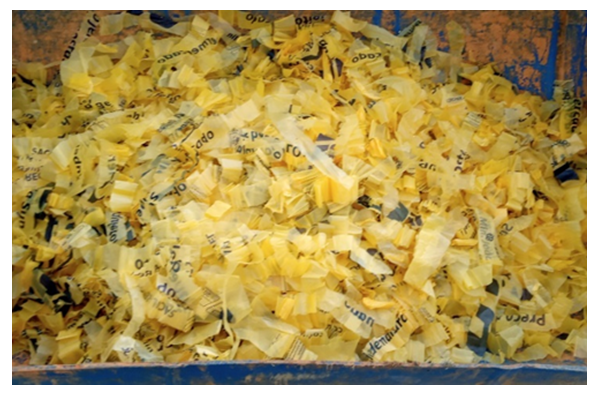 | Figure 1. Polyethylene Fibers |
2.4. Expanded Polystyrene Waste
- The expanded polystyrene waste was originated from packaging of household appliances that would be improperly discarded. The packaging was collected, cleaned, and processed using a common blender. In order to achieve good particle dispersion, the waste processing was done in several stages with small quantities, resulting in the material shown in Figure 2. In total, approximately 350 grams of processed expanded polystyrene was used. For the characterization of the obtained material, a granulometric analysis was conducted by washing a processed waste sample through sieves with openings of 19.00, 9.50, 4.75, 2.36, 2.00, 1.40, and 0.30 mm.
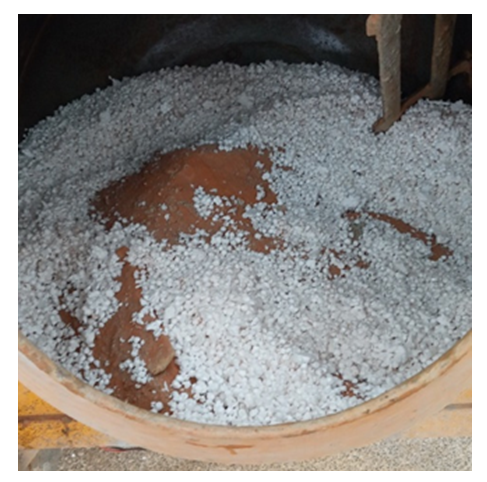 | Figure 2. Processed expanded polystyrene waste being mixed with soil |
2.5. Adobe Brick Confection
- Four groups of adobe bricks were manufactured, with the first group consisting of soil-cement blocks, the second group of soil-cement blocks with the addition of polyethylene fibers, and the third group of soil-cement blocks with the addition of expanded polystyrene waste. The fourth group was produced based on the content of each waste (polyethylene and EPS) that individually showed the best performance in the second and third group. These were combined to create a fourth group of soil-cement blocks with the addition of EPS waste and reinforced with polyethylene fibers. The produced mixtures were subjected to uniaxial compressive strength tests and shrinkage tests.The adobe bricks production process involves initially moistening the walls of the concrete mixer with water, adding the pre-mixed soil, cement, and waste blend, and finally, gradually adding water to the mixture until a plastic consistency is achieved [31]. It is emphasized that the amount of water used in the production of a mixture was replicated in subsequent productions, when necessary, to ensure the same moisture for all blocks of the same mixture. All waste and cement content were considered relative to the mass of dry soil. The produced mixtures and their respective compositions are shown in Table 2.
|
 | Figure 3. Adobe brick confection |
2.6. Uniaxial Compressive Strength Test
- The uniaxial compression strength test was conducted with the aim of verifying the effect that the addition of residues has on the compression strength of the soil-cement adobe brick compared to bricks without any type of addition. The preparation of the test specimens involved mortaring the upper face of the brick with cement mortar after a curing period of 7 days. As proposed by Silva [32] and Schweig et al. [21], the mortar produced for this purpose has a ratio of 1:2 (one part cement and two parts sand), with a moisture content of 25%, and is applied with a maximum thickness of 3 mm. This proce-dure aimed to parallelize the compressed faces. In Figure 4, the appearance of the blocks after capping is presented.
 | Figure 4. Appearance of the bricks after mortaring |
2.7. Shrinkage Test
- The shrinkage test was conducted with mixtures containing residue in their composition, following the procedure proposed by the Research and Development Center (CEPED) [31]. In this test, a mixture is considered suitable when, upon analysis of the results, it shows no cracks or shrinkage greater than 2 centimeters. The procedure involves preparing a plastic-consistency mass, similar to clay, which is placed in the testing box with internal dimensions of 3.5 cm in height, 8.5 cm in width, and 60 cm in length. Figure 5 illustrates the procedure for placing the mixtures in the testing box.
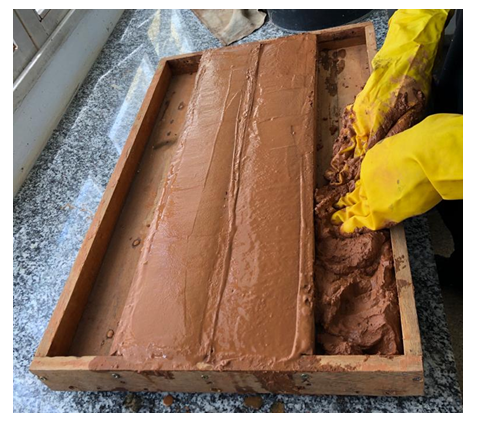 | Figure 5. Accommodation of mixtures in the shrinkage test box |
3. Results and Discussion
- This section presents and discusses the results obtained considering the proposed methodology. Firstly, the results related to bricks with the incorporation of EPS residue are presented, followed by the results related to bricks reinforced with polyethylene fibers. The analysis of these results defines the optimal content for each residue, and finally, the results related to blocks with the addition of EPS residue reinforced with polyethylene fibers are presented.
3.1. Soil-Cement with Addition of EPS Waste
- While processing expanded polystyrene, a variation in the particle size was observed. This variation in particle dimensions was evaluated through a granulometric analysis by washing. By weighing the fraction of particles retained on each sieve, it was possible to plot the particle size distribution curve of the residue, as shown in Figure 6. It can be observed that the curve has a vertical development, indicating a uniform gradation.
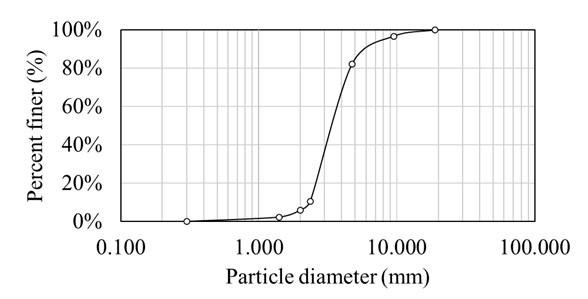 | Figure 6. Granulometric curve of expanded polystyrene (EPS) waste |
|
 | Figure 7. Average compressive strength after 7 days of curing – bricks with EPS |
|
 | Figure 8. Average compressive strength after immersion in water - bricks with EPS |
 | Figure 9. Shrinkage test: soil-cement with EPS residue |
|
 | Figure 10. Average density of bricks with EPS after 7 days of curing |
3.2. Soil-Cement with Addition of Polyethylene Fibers
- The average values of uniaxial compressive strength for soil-cement bricks reinforced with polyethylene fibers are presented in Figure 11 and Table 6. Overall, it is observed that the addition of fibers resulted in an increase in the compression strength of the bricks.
|
 | Figure 11. Average compressive strength after 7 days of curing – bricks with polyethylene fibers |
|
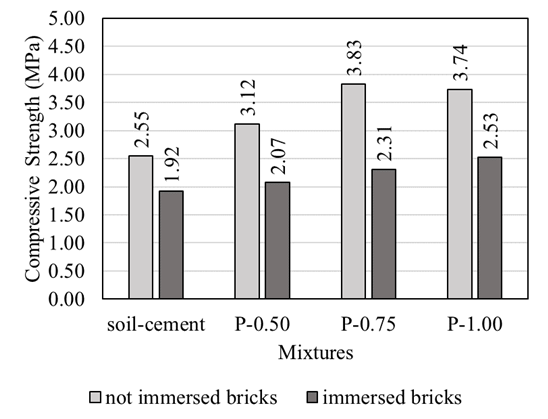 | Figure 12. Average compressive strength after immersion in water - bricks with polyethylene fibers |
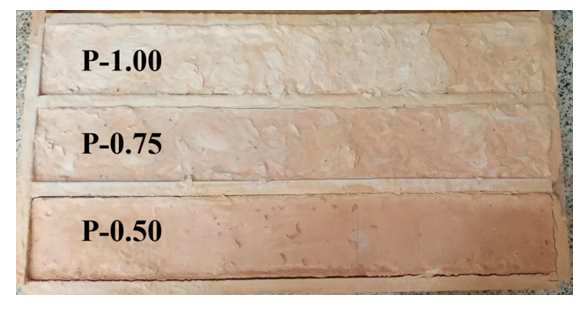 | Figure 13. Shrinkage test: soil-cement with polyethylene fibers |
|
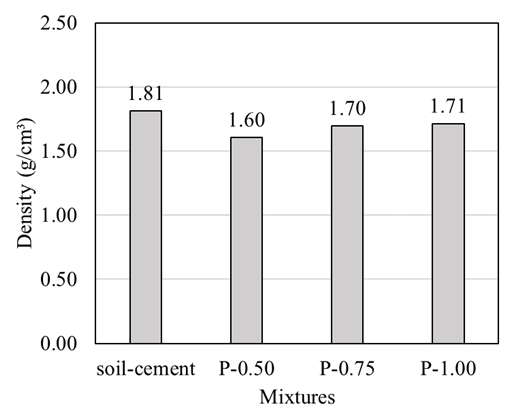 | Figure 14. Average density of bricks with polyethylene fibers after 7 days of curing |
3.3. Soil-Cement with Addition of EPS Waste Reinforced with Polyethylene Fibers
- The average values of uniaxial compressive strength for soil-cement blocks with the addition of EPS residue reinforced with polyethylene fibers, both immersed and non-immersed in water, are presented in Figure 15 and Table 9. Overall, it is noted that the simultaneous addition of residues was beneficial for the compression strength of the brick, especially in the case without water immersion.
|
 | Figure 15. Average compressive strength after immersion in water - bricks with EPS + polyethylene fibers |
 | Figure 16. Shrinkage test: soil-cement with EPS + polyethylene fibers |
|
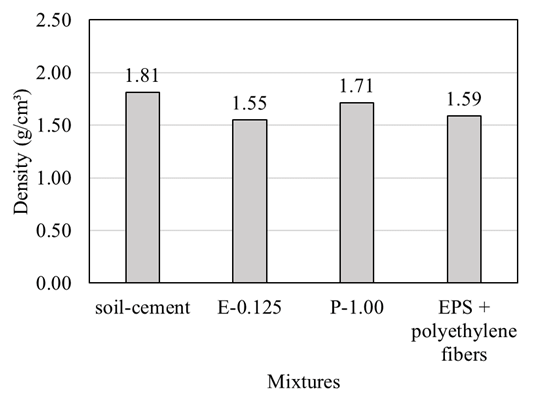 | Figure 17. Average density of bricks after 7 days of curing |
4. Conclusions
- The incorporation of expanded polystyrene residue was carried out with the aim of reducing the weight of adobe bricks, which was indeed achieved. However, this incorporation resulted in an 85% loss of compressive strength for the mixture containing 0.50% incorporation of this residue, along with cracks in the shrinkage test. On the other hand, the incorporation of polyethylene fibers was primarily aimed at containing the cracking of the soil-cement matrix in the shrinkage test. The incorporation of these fibers, at the studied levels, not only restrained the shrinkage of the soil-cement mixture but also provided an increase in compressive strength.From a normative perspective, the mixtures E-0.125, E-0.25, and E-0.50, for a curing period of 7 days, do not meet the compressive strength criterion of equal to or greater than 1.5 MPa, as specified by NBR 16814 (ABNT, 2020). Despite the other mixtures meeting this criterion, it is emphasized that the method for evaluating compressive strength outlined in the Brazilian standard is different from what was used in the development of this study.The results of the tests with the soil-cement adobe bricks incorporating EPS residue and reinforced with polyethylene fibers were satisfactory in terms of compressive strength and shrinkage. The brick produced with the simultaneous incorporation of residues, besides being lighter, showed an average compressive strength 59% higher than the reference soil-cement block, and it did not exhibit cracks or fissures in the shrinkage test.
ACKNOWLEDGEMENTS
- For all the provided support, the authors thanks the Federal University of Mato Grosso (UFMT).
 Abstract
Abstract Reference
Reference Full-Text PDF
Full-Text PDF Full-text HTML
Full-text HTML






